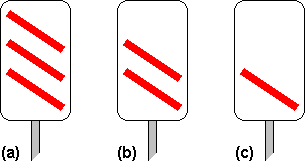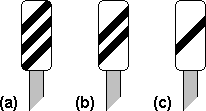|
|
|
|
|
|
|
|
|
On the Scottish Region, signal M183 at Uddingston had been passed at 'danger' on numerous occasions. Although the sighting was good, drivers of light engines in particular had been misjudging their braking on the downhill approach to the signal. The problem was addressed in July 1987 by the provision of experimental countdown markers on the approach to the signal. The markers, which had red diagonal bars on a white rectangular background [8.21], were installed at 436 yards (399 metres), 294 yards (269 metres) and 160 yards (146 metres) on approach to the signal. This style of countdown marker was subsequently adopted nationally as one means of reducing SPAD occurrences at signals that have a history of such incidents or are considered to be 'high risk'. The markers were usually installed at standard distances of 300 metres, 200 metres and 100 metres from the relevant signal.
 |
|
[8.21] Countdown Markers ( (a) - Outer board; (b) - Intermediate board; (c) - Inner board ).
Area: All Areas Usage: High Status: Obsolescent |
|---|
In February 1988, experimental countdown markers were installed on the approaches to two signals on the Western Region; one at Reading East and one at Thatcham. In each case the markers, which had black diagonal stripes on a white background [8.22], were installed at 300 yards (274 metres), 200 yards (183 metres) and 100 yards (91 metres) on approach to the corresponding signal. In July of the same year, similar markers were installed at the same distances on the approaches to two signals at Preston (London Midland Region).
 |
|
[8.22] Countdown Markers ( (a) - Outer board; (b) - Intermediate board; (c) - Inner board ).
Area: Various Usage: Low Status: Historical |
|---|
|
Five experimental boards were installed between Chichester and Warblington (Southern Region) when the line was resignalled in November 1992. These comprised a white triangular board with a red border and a large exclamation mark [8.24]. Each board was installed at generally 650 yards (594 metres) on the approach to a stop signal, and all but one were accompanied by an AWS warning indication. These boards were intended to assist drivers in locating the signals concerned. They were removed in June 1999. |
|
|
There may be justification for making a particular colour light main signal or position light shunting signal more conspicuous than normal. This could be because of problems with misreading where signals are positioned alongside one another, or because the signal concerned has a history of being passed at 'danger' (a 'multi-SPAD' signal). The solution most commonly adopted, from 1994, was to fit a blue and white diagonally striped surround around the signal head [8.25]. This primarily assists with close-range viewing. Some colour light signals had this type of edging applied to an associated position light signal or junction indicator but not to the main signal head. In one instance where a striped surround was fitted, the signal's identification plate was replaced by one that had a blue background (see [9.54]). |
|
Some of the stop signals identified as having a potentially higher risk of being passed at 'danger' are those that are located some distance ahead of a station platform (or other distraction) but are not visible from the platform. There is a danger that a driver could forget the previous caution aspect while stopped at the station, and on departure accelerate to a speed that leaves insufficient braking distance to stop at the next signal when it suddenly comes into view. To help prevent such an occurrence, signs of a new design [8.26] were installed ahead of Glengarnock station on the Scotland Zone in June 1994. Also in June 1994, notice boards to prevent station overshoots were installed on both approaches to Langbank and Kilpatrick stations on the Scotland Zone [8.27].
 |
 |
|
[8.26] Signal Reminder Board (e.g. refers to signal number PG182).
Area: Glengarnock Usage: Low Status: Historical |
[8.27] 'Station Ahead' Board (e.g. 1000 yards to Kilpatrick station).
Area: Langbank / Kilpatrick Usage: Low Status: Obsolescent |
|---|
Line reminder boards have been installed at a number of signals within complex layouts, mostly those that are mounted on gantries. The boards generally had black characters on a white background [8.28], except that those on the Great Western and Southern Zones usually had a yellow background [8.29]. Line reminder boards of a circular shape [8.30] were provided at some locations (e.g. between Manchester Piccadilly and Ardwick Junction).
 |
 |
 |
|
[8.28] Line Reminder Board with white background (e.g. "UG" for 'Up Goods').
Area: Various Usage: Medium Status: Obsolescent |
[8.29] Line Reminder Board with yellow background (e.g. "UBS" for 'Up Brighton Slow').
Area: Great Western and Southern Zones Usage: Medium Status: Obsolescent |
[8.30] Line Reminder Board (e.g. "DE" for 'Down East line').
Area: Various Usage: Medium Status: Obsolescent |
|---|
Following a series of high-profile accidents resulting from SPADs, the 'SPAD indicator' was introduced as a secondary warning device, to be placed ahead of selected 'high risk' signals. The signals involved have often tended to be platform starting signals that protect junctions. In normal circumstances, a SPAD indicator is unlit, but will be activated in the event of an associated signal being passed at 'danger'. When activated, the original form of indicator displayed the word "stop" vertically in red illuminated letters, with flashing red lights above and below [8.31]. Only two examples of this type were ever installed, the first beyond signal S198 at Meadowhall in October 1994 and the second beyond signal L293 at Maryland in April 1996. Later SPAD indicators installed in 1996 were based around a conventional three-aspect colour light signal head, but with a distinctive blue backboard to avoid them being mistaken as defective colour light signals when unlit. All three lenses were red, and the middle one had the word "stop" written across it. When activated, the top and bottom lights flash, and the middle light shows a steady red [8.32]. Further installations made from 1996 onwards omitted the word "stop" on the middle lens [8.33]. Since the introduction of the Train Protection & Warning System (TPWS), which can intervene to stop a train, very few new SPAD indicators were provided, and some existing examples have been removed.
 |
 |
 |
|
[8.31] SPAD Indicator.
Area: Meadowhall / Maryland Usage: Low Status: Historical |
[8.32] SPAD Indicator.
Area: All Areas Usage: Medium Status: Obsolescent |
[8.33] SPAD Indicator.
Area: All Areas Usage: Medium Status: Obsolescent |
|---|
In August 1996, a signal reminder board was experimentally installed on approach to signal L549 at Wickford (East Anglia Zone). This consisted of a yellow triangular board showing an exclamation mark, with a supplementary sign below stating the distance to the signal ahead as well as its number, on a white background [8.34]. Later in the same month, a signal reminder board of a different design was installed at Falkirk Grahamston (Scotland Zone). The triangular board with the exclamation mark had a white background with a red border, and the supplementary sign below was worded "signal ahead" [8.35].
 |
 |
|
[8.34] Signal Reminder Board.
Area: East Anglia Zone Usage: Medium Status: Obsolescent |
[8.35] Signal Reminder Board.
Area: Scotland, North West and Midlands Zones Usage: Medium Status: Obsolescent |
|---|
The remodelling of London Paddington in 1993 provided six bi-directionally signalled lines on the approach to the station, designated "Line 1" to "Line 6". To help drivers identify which signal applied to their train, line reminder boards were installed in both directions in December 1996. Each board had the applicable line name superimposed on a white symbol, the shape of which was unique to that line [8.36]. The boards were mounted beside or above the gantry-mounted signal heads and also in the 'four-foot' on approach to each signal, mostly before the associated AWS magnet. These boards were removed in April 2003.
 |
|
[8.36] Line Reminder Boards.
Area: London Paddington Usage: Low Status: Historical |
|---|
|
|
|